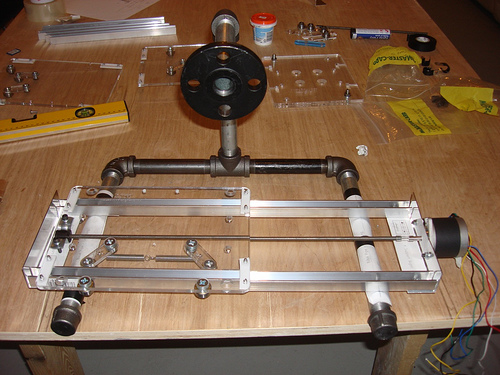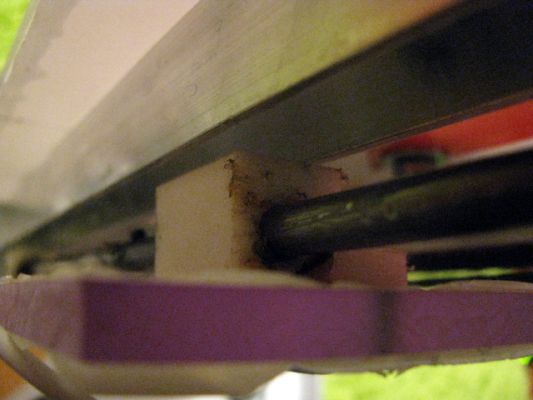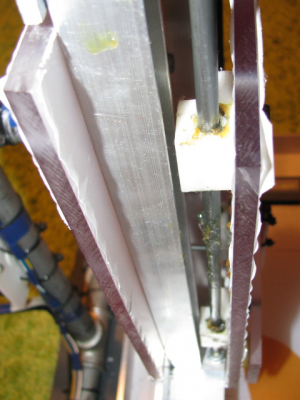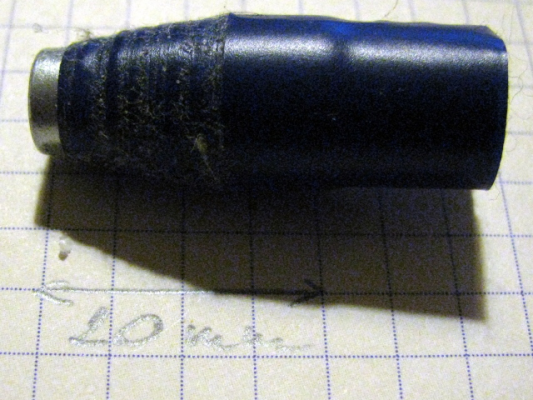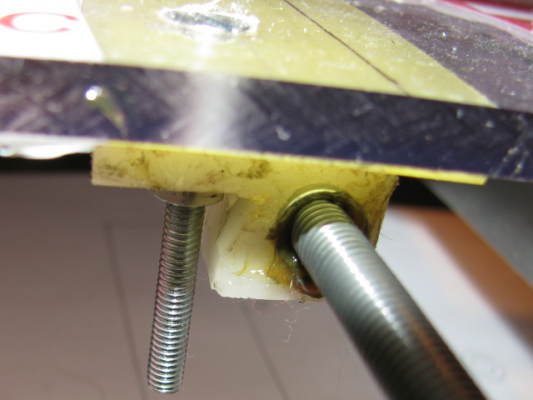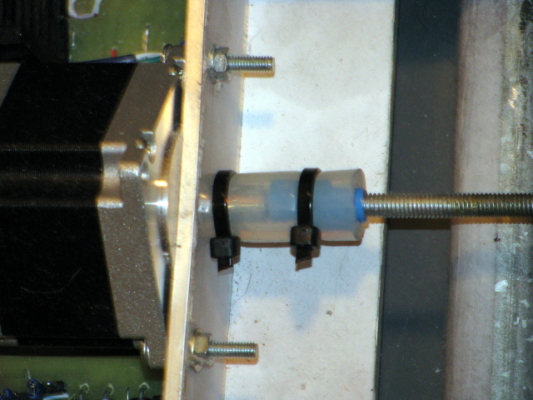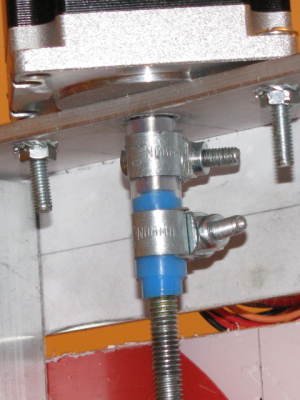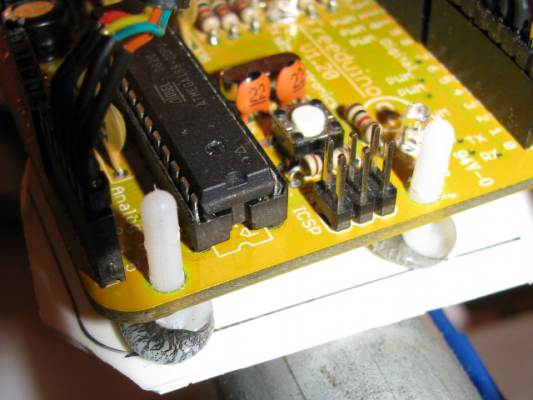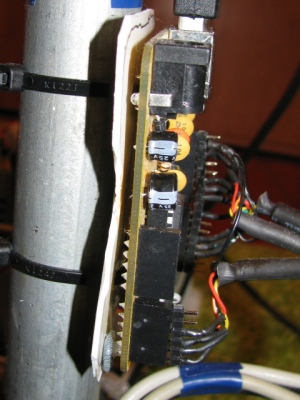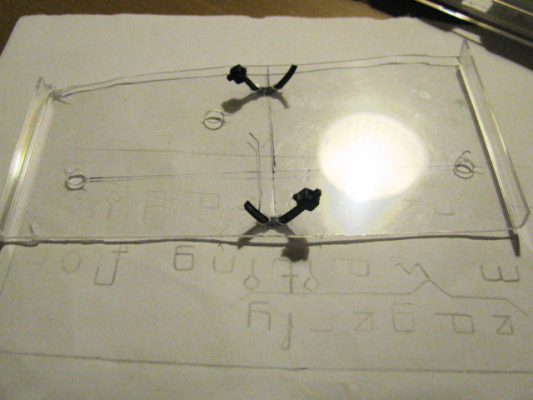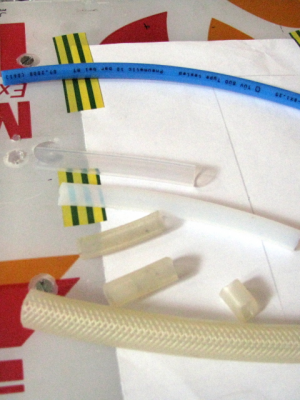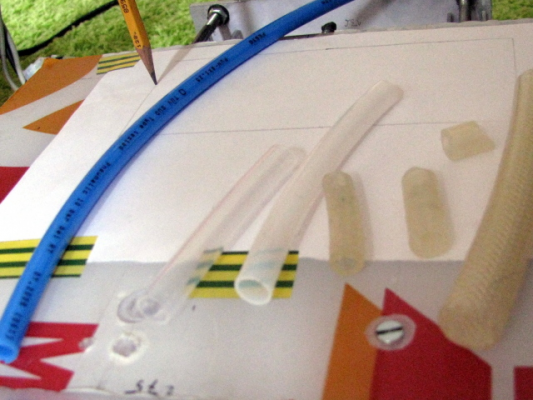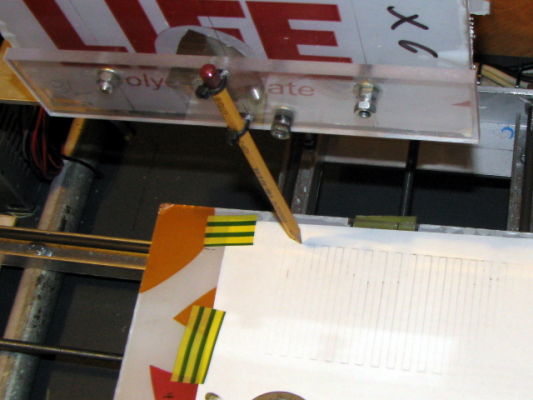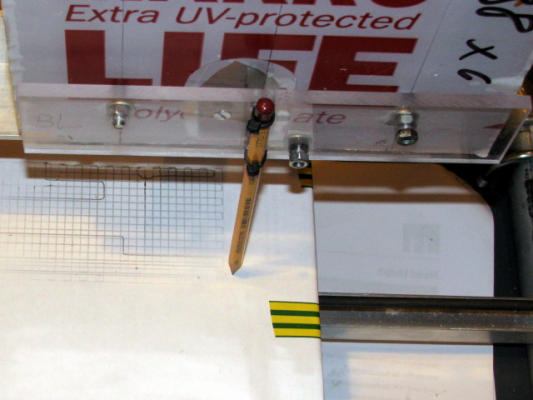List of improvements of my McWire-variant
Posted by khiraly
|
List of improvements of my McWire-variant January 22, 2009 01:07PM |
Registered: 16 years ago Posts: 204 |
List of improvements of my McWire-variant
Hi!
As I promised[1], I write up all my modifications compared to
the original one listed on the reprap wiki[2].
The state of the machine:
done:
- mechanically works, all the 3 axis moves, with motors.
- arduino controls these motors with the 1.3 arduino firmwares
- I drive it with the skeinforge's send.py program.
- I have a pen holder mounted
- I mounted all the electronics and mechanics to a 12mm thick PVC table,
so it is ready-made (only need an usb cable and a mains cable). I can easily
move around the whole machine, its about 15-20 kg.
NOT done:
- I do not have a printing head
- I do not have any axis limiter (opto-endstop, mechanical switch)
- I do not have an extruder controller electronics
- I didnt try (yet) the machine with a dremel tool (but I will)
Here is a video of my machine when working with a pen, I filmed the machine
from every possible direction: []
List of modifications:
1. PTFE blocks for sliding
I eliminated the skate roller design, because of three things:
- I couldnt buy springs with the right size
- Aluminium wears quickly against steel (aluminium channel vs. roller bearings)
- maybe it could have some movements not parallel to the axis. So the X axe could
move slightly toward the Y axe. So it is not suitable for milling (need to verify,
it is just a clue).
Here is the photo of the original design:
[farm3.static.flickr.com]
And here is a photo of my mountings
So I used 6mm steel rod for guide, and on these guides slide
4 ptfe block (drilled through 6.1mm drill bit).
Drilling and mounting these blocks is a bit hard, a drill press is
absolutely necessary (I went to my friend's workplace, and made it there)
Once I have a printing head, I will make a trolley with 8mm hole in it, and
will use ptfe tube (6mm inner diameter and 8 mm outer diameter) for sliding.
2. Nut mounting
If I see right the photo on the reprap wiki page
(http://flickr.com/photos/hoeken/2293531019/in/set-72157603779940311/ )
The nut is whiped round with an insulation stripe and mounted using a piece of metal.
I tried this method, but when my repstrap changed the direction the nut
get pulled from the insulation stripe.
So I needed a more robust solution.
I use longer nuts which has 8 mm outer diameter (and 20mm long),
I mounted inside an another ptfe block what has been drilled with
a 8mm drill bit, then I used a hammer to nail it inside the block.
So the ptfe block and the nut fits exactly, and the nut does not move.
There are practically no backlash (I cant see it, but need more testing),
but it is really noisy, the metal slides against the metal, and it resonates
sometimes. I use lot of grease (lubricant), to reduce friction to the minimum.
In the future I plan to use nut made of ptfe (teflon) or danamid.
It has no backlash (I read it on a CNC site[3] as possible backlash-free solution),
there are more possible way, one of them are what Forrest presented on his site[4].
3. Motor connections
The reprap wiki suggests to use aquarium tubing as motor connections without
any clamp.
The aquarium tubing, is a silicon tube with 1mm wall thickness if Im right.
It IS elastic, way more than it is needed.
I have explored different tubes (I was in a silicon specialist shop and a
teflon specialist shop too), and I share with you my findings.
As I made all my axis by hand basically using a accu-drill and a dremel
it contains some errors/misalignement. I think my best "resolution" is between
1-2mm. I cant drill holes or position more accurately then 1mm.
I have buyed 6, 6.1, 6.2, 6.3mm diameter drill bit, and I cant make difference
between them using my eyes (I need a caliper or read the texts on it), I tried
two other people, but they also picked the wrong bit, when I asked them to
organize it by their diameter without reading the text on it.
So when I mounted my plastic table on the four ptfe block the tables hardly
moved along the axis. That means, when the stepper motor turns, the aquarium
tubing elongate 1-2mm before the axis started moving.
My best axis was the X, that I could easily move by hand, the Y axis was a
bit worst, but not much. The Z axis other part didnt moved easily, and
at the bottom I could only move it with an enormous force.
So I buyed different material for the motor to play with:
8mm inner diameter teflon (ptfe tube) (~20$/meter)
8mm inner diameter pfe tube (~25$/meter)
8mm inner diameter and 16mm outer diameter silicon tube
(I got 5cm for free from the shop to try it out
8mm inner diameter and 15mm outer diameter silicon
tube with textil hardening inside (~15$/meter)
I had a 6mm inner and 8mm outer diameter Festo pneumatic tube,
which is much like the teflon tube, but has a nice blue color
(my friend told me, that the festo tube is not teflon, but couldnt
tell what material is)
My threaded rod is 6mm diameter, and the motor shaft is 8mm.
So I mounted 1.5-2cm festo tube on the threaded rod to make it
8mm diameter, than I used the tubes.
For the X and Y I used the silicon tube (16mm outer diameter) and
cable ties as the clamp. Works great.
For the Z axis which moves really hard, I used the ptfe tube with
proper pneumatic clamp to stretch it hard.
The Z axis works great I can lift and put it down by 0.1mm easily.
It is necessary if I want to lift the pen and put it back on the paper.
(or if I want to do milling). For the Z axis it needs to hold
all the load, so it is better to use material which elongate the less
(ptfe, pfe tubes).
The axis will be wear together with time (ptfe against the steel rod).
So I recommend ptfe or pfe tube for the motor connection with tube clamp.
(pfe is a bit more rigid then ptfe and more transparent and more expensive).
4. Mounted everything on a pvc table
It is nice, because I could fix my cartesian bot to this pvc table,
so my cartesian bot does not move, or misalign.
What is rest, is I will fix the z axis' pipe using a screw. (I will
drill through everything, and screw on a screw)
I mounted the arduino to the pipe using a CD case and lollipop handles
and a lighter
5. pen holder
The pen holder went through also two iteration. The first was made of
CD case and cable tie. The CD case deformed along the Y axis.
So the second iteration used more thick plastic as the other parts of the
machine. Now only the pen deformate if it is pressed hard against the paper.
(sorry I cant post more image to this post)
6. Aluminium angle
As suggested on the wiki I used more thick aluminium angle. So I used 4mm wall
thickness. But more thick the better.
7. Metric units
I dont know if it is improvements, but I converted everything to metric units,
and choosed the closest available part.
I will also upload the movie at later tonight (It disconnected twice today,
so I was unable to upload to vimeo.com).
If you have questions, feel free to ask. And sorry, I didnt write that long text before
if it is hard to follow, I can rephrase where necessary. (Im not a native speaker)
[1]: [forums.reprap.org]
[2]: [reprap.org]
[3]: [www.hobbycnc.hu]
[4]: [www.3dreplicators.com]
Hi!
As I promised[1], I write up all my modifications compared to
the original one listed on the reprap wiki[2].
The state of the machine:
done:
- mechanically works, all the 3 axis moves, with motors.
- arduino controls these motors with the 1.3 arduino firmwares
- I drive it with the skeinforge's send.py program.
- I have a pen holder mounted
- I mounted all the electronics and mechanics to a 12mm thick PVC table,
so it is ready-made (only need an usb cable and a mains cable). I can easily
move around the whole machine, its about 15-20 kg.
NOT done:
- I do not have a printing head
- I do not have any axis limiter (opto-endstop, mechanical switch)
- I do not have an extruder controller electronics
- I didnt try (yet) the machine with a dremel tool (but I will)
Here is a video of my machine when working with a pen, I filmed the machine
from every possible direction: []
List of modifications:
1. PTFE blocks for sliding
I eliminated the skate roller design, because of three things:
- I couldnt buy springs with the right size
- Aluminium wears quickly against steel (aluminium channel vs. roller bearings)
- maybe it could have some movements not parallel to the axis. So the X axe could
move slightly toward the Y axe. So it is not suitable for milling (need to verify,
it is just a clue).
Here is the photo of the original design:
[farm3.static.flickr.com]
And here is a photo of my mountings
So I used 6mm steel rod for guide, and on these guides slide
4 ptfe block (drilled through 6.1mm drill bit).
Drilling and mounting these blocks is a bit hard, a drill press is
absolutely necessary (I went to my friend's workplace, and made it there)
Once I have a printing head, I will make a trolley with 8mm hole in it, and
will use ptfe tube (6mm inner diameter and 8 mm outer diameter) for sliding.
2. Nut mounting
If I see right the photo on the reprap wiki page
(http://flickr.com/photos/hoeken/2293531019/in/set-72157603779940311/ )
The nut is whiped round with an insulation stripe and mounted using a piece of metal.
I tried this method, but when my repstrap changed the direction the nut
get pulled from the insulation stripe.
So I needed a more robust solution.
I use longer nuts which has 8 mm outer diameter (and 20mm long),
I mounted inside an another ptfe block what has been drilled with
a 8mm drill bit, then I used a hammer to nail it inside the block.
So the ptfe block and the nut fits exactly, and the nut does not move.
There are practically no backlash (I cant see it, but need more testing),
but it is really noisy, the metal slides against the metal, and it resonates
sometimes. I use lot of grease (lubricant), to reduce friction to the minimum.
In the future I plan to use nut made of ptfe (teflon) or danamid.
It has no backlash (I read it on a CNC site[3] as possible backlash-free solution),
there are more possible way, one of them are what Forrest presented on his site[4].
3. Motor connections
The reprap wiki suggests to use aquarium tubing as motor connections without
any clamp.
The aquarium tubing, is a silicon tube with 1mm wall thickness if Im right.
It IS elastic, way more than it is needed.
I have explored different tubes (I was in a silicon specialist shop and a
teflon specialist shop too), and I share with you my findings.
As I made all my axis by hand basically using a accu-drill and a dremel
it contains some errors/misalignement. I think my best "resolution" is between
1-2mm. I cant drill holes or position more accurately then 1mm.
I have buyed 6, 6.1, 6.2, 6.3mm diameter drill bit, and I cant make difference
between them using my eyes (I need a caliper or read the texts on it), I tried
two other people, but they also picked the wrong bit, when I asked them to
organize it by their diameter without reading the text on it.
So when I mounted my plastic table on the four ptfe block the tables hardly
moved along the axis. That means, when the stepper motor turns, the aquarium
tubing elongate 1-2mm before the axis started moving.
My best axis was the X, that I could easily move by hand, the Y axis was a
bit worst, but not much. The Z axis other part didnt moved easily, and
at the bottom I could only move it with an enormous force.
So I buyed different material for the motor to play with:
8mm inner diameter teflon (ptfe tube) (~20$/meter)
8mm inner diameter pfe tube (~25$/meter)
8mm inner diameter and 16mm outer diameter silicon tube
(I got 5cm for free from the shop to try it out

8mm inner diameter and 15mm outer diameter silicon
tube with textil hardening inside (~15$/meter)
I had a 6mm inner and 8mm outer diameter Festo pneumatic tube,
which is much like the teflon tube, but has a nice blue color
(my friend told me, that the festo tube is not teflon, but couldnt
tell what material is)
My threaded rod is 6mm diameter, and the motor shaft is 8mm.
So I mounted 1.5-2cm festo tube on the threaded rod to make it
8mm diameter, than I used the tubes.
For the X and Y I used the silicon tube (16mm outer diameter) and
cable ties as the clamp. Works great.
For the Z axis which moves really hard, I used the ptfe tube with
proper pneumatic clamp to stretch it hard.
The Z axis works great I can lift and put it down by 0.1mm easily.
It is necessary if I want to lift the pen and put it back on the paper.
(or if I want to do milling). For the Z axis it needs to hold
all the load, so it is better to use material which elongate the less
(ptfe, pfe tubes).
The axis will be wear together with time (ptfe against the steel rod).
So I recommend ptfe or pfe tube for the motor connection with tube clamp.
(pfe is a bit more rigid then ptfe and more transparent and more expensive).
4. Mounted everything on a pvc table
It is nice, because I could fix my cartesian bot to this pvc table,
so my cartesian bot does not move, or misalign.
What is rest, is I will fix the z axis' pipe using a screw. (I will
drill through everything, and screw on a screw)
I mounted the arduino to the pipe using a CD case and lollipop handles
and a lighter

5. pen holder
The pen holder went through also two iteration. The first was made of
CD case and cable tie. The CD case deformed along the Y axis.
So the second iteration used more thick plastic as the other parts of the
machine. Now only the pen deformate if it is pressed hard against the paper.
(sorry I cant post more image to this post)
6. Aluminium angle
As suggested on the wiki I used more thick aluminium angle. So I used 4mm wall
thickness. But more thick the better.
7. Metric units
I dont know if it is improvements, but I converted everything to metric units,
and choosed the closest available part.
I will also upload the movie at later tonight (It disconnected twice today,
so I was unable to upload to vimeo.com).
If you have questions, feel free to ask. And sorry, I didnt write that long text before
if it is hard to follow, I can rephrase where necessary. (Im not a native speaker)
[1]: [forums.reprap.org]
[2]: [reprap.org]
[3]: [www.hobbycnc.hu]
[4]: [www.3dreplicators.com]
|
Re: List of improvements of my McWire-variant January 22, 2009 01:29PM |
Registered: 16 years ago Posts: 204 |
I couldnt attache more image to my initial post, so here goes the rests.
The different tubes what I got:
From left to right:
the blue one is the Festo tube,
the transparent is the pfe
the semi-transparent (milk-like) is the ptfe tube
pneumatic silicone tube (bit stronger then aquarium tubes) 1, 2, 3
the last one is the 15mm outer diammeter silicon tube with textil
(for make a bit stronger).
What is not on this picture is the another 16mm outer diameter
silicon tube, but you can see it on the motor_connection photo.
And here is my final pen holder:
The different tubes what I got:
From left to right:
the blue one is the Festo tube,
the transparent is the pfe
the semi-transparent (milk-like) is the ptfe tube
pneumatic silicone tube (bit stronger then aquarium tubes) 1, 2, 3
the last one is the 15mm outer diammeter silicon tube with textil
(for make a bit stronger).
What is not on this picture is the another 16mm outer diameter
silicon tube, but you can see it on the motor_connection photo.
And here is my final pen holder:
|
Re: List of improvements of my McWire-variant January 22, 2009 01:45PM |
Admin Registered: 17 years ago Posts: 1,915 |
This is great stuff, khiraly! Are you not putting this in the builders' blog because you can't get put on the list of posters?
-------------------------------------------------------
Hell, there are no rules here - we're trying to accomplish something.
Opportunity is missed by most people because it is dressed in overalls and looks like work.
Thomas A. Edison
-------------------------------------------------------
Hell, there are no rules here - we're trying to accomplish something.
Opportunity is missed by most people because it is dressed in overalls and looks like work.
Thomas A. Edison
|
Re: List of improvements of my McWire-variant January 22, 2009 03:56PM |
Registered: 16 years ago Posts: 204 |
|
Re: List of improvements of my McWire-variant January 22, 2009 04:03PM |
Admin Registered: 17 years ago Posts: 1,915 |
khiraly Wrote:
-------------------------------------------------------
>
> I do not have a blog, and I didnt want to create
> just for this post.
>
That's what the builder's blog is for. :-)
[builders.reprap.org]
> > Fara hvar enginn mega fylgja
> Which language and what it means?
Old Norse (viking, if you will)...
Go (lit. fare) where none may follow. {personal motto}
Old Norse isn't all that different from modern English.
-------------------------------------------------------
Hell, there are no rules here - we're trying to accomplish something.
Opportunity is missed by most people because it is dressed in overalls and looks like work.
Thomas A. Edison
-------------------------------------------------------
>
> I do not have a blog, and I didnt want to create
> just for this post.
>
That's what the builder's blog is for. :-)
[builders.reprap.org]
> > Fara hvar enginn mega fylgja
> Which language and what it means?
Old Norse (viking, if you will)...
Go (lit. fare) where none may follow. {personal motto}

Old Norse isn't all that different from modern English.
-------------------------------------------------------
Hell, there are no rules here - we're trying to accomplish something.
Opportunity is missed by most people because it is dressed in overalls and looks like work.
Thomas A. Edison
|
Re: List of improvements of my McWire-variant January 23, 2009 08:44AM |
Registered: 16 years ago Posts: 204 |
|
Re: List of improvements of my McWire-variant January 23, 2009 09:14AM |
Admin Registered: 17 years ago Posts: 1,915 |
Sounds like you are giving it about 60 steps/second. Is that as fast as it will go?
-------------------------------------------------------
Hell, there are no rules here - we're trying to accomplish something.
Opportunity is missed by most people because it is dressed in overalls and looks like work.
Thomas A. Edison
-------------------------------------------------------
Hell, there are no rules here - we're trying to accomplish something.
Opportunity is missed by most people because it is dressed in overalls and looks like work.
Thomas A. Edison
|
Re: List of improvements of my McWire-variant January 23, 2009 10:40AM |
Registered: 16 years ago Posts: 204 |
> Sounds like you are giving it about 60 steps/second. Is that as fast as it will go?
What is the minimum requirement?
I had a thread in the past about exactly this problem (http://forums.reprap.org/read.php?13,18493).
I can film it at the maximum speed, it can be faster but not too much.
Here is my exact settings:
So what (maximum) speed are you recommending?
Thanks, for helping.
Best regards,
Khiraly
ps: I try to get some milling bits and I try to make some pcb next week.
Any recommendation?
What is the minimum requirement?
I had a thread in the past about exactly this problem (http://forums.reprap.org/read.php?13,18493).
I can film it at the maximum speed, it can be faster but not too much.
Here is my exact settings:
// define the parameters of our machine. #define X_STEPS_PER_INCH 5080 #define X_STEPS_PER_MM 200 #define X_MOTOR_STEPS 200 #define Y_STEPS_PER_INCH 5080 #define Y_STEPS_PER_MM 200 #define Y_MOTOR_STEPS 200 #define Z_STEPS_PER_INCH 5080 #define Z_STEPS_PER_MM 200 #define Z_MOTOR_STEPS 200 //our maximum feedrates #define FAST_XY_FEEDRATE 80.0 #define FAST_Z_FEEDRATE 80.0
So what (maximum) speed are you recommending?
Thanks, for helping.
Best regards,
Khiraly
ps: I try to get some milling bits and I try to make some pcb next week.
Any recommendation?
|
Re: List of improvements of my McWire-variant January 23, 2009 10:45AM |
Registered: 16 years ago Posts: 204 |
|
Re: List of improvements of my McWire-variant January 23, 2009 11:16AM |
Admin Registered: 17 years ago Posts: 1,915 |
khiraly Wrote:
-------------------------------------------------------
>
> I think you and nophead suggesting 8mm/s and even
> 16mm/s.
> Am I right?
>
Yes.
>
> I will test it and makes video.
>
Good luck!
-------------------------------------------------------
Hell, there are no rules here - we're trying to accomplish something.
Opportunity is missed by most people because it is dressed in overalls and looks like work.
Thomas A. Edison
-------------------------------------------------------
>
> I think you and nophead suggesting 8mm/s and even
> 16mm/s.
> Am I right?
>
Yes.
>
> I will test it and makes video.
>
Good luck!

-------------------------------------------------------
Hell, there are no rules here - we're trying to accomplish something.
Opportunity is missed by most people because it is dressed in overalls and looks like work.
Thomas A. Edison
|
Pyros
Re: List of improvements of my McWire-variant January 26, 2009 08:27PM |
There's gotta be a better way to connect the motor head to the rod.
My thinking is along the line of notching the motor head and fabbing a "key" that tightly screws onto the rod and snugly goes over the motor head--if done right, seating won't be a huge issue as long as the rod is stable.
My thinking is along the line of notching the motor head and fabbing a "key" that tightly screws onto the rod and snugly goes over the motor head--if done right, seating won't be a huge issue as long as the rod is stable.
|
Re: List of improvements of my McWire-variant January 26, 2009 10:31PM |
Registered: 16 years ago Posts: 536 |
Actually, the flexible coupler bit is genius, especially on this sort of low-accuracy design. It lets you have a lot of misalignments on your setup, even a slightly bent rod, and it still works great.
Rigid shaft connections are big trouble unless everything is absolutely straight - you get huge stresses and wear. Check out the SDP/SI page on couplers - only one type on the whole page is rigid.
[www.sdp-si.com]
I used a rigid steel coupler on my Z axis after I broke the plastic one, but it's been nothing but problems for me, a big mistake. The only thing that saved me was the fact that my motor mount is relatively weak, and it flexes as the shaft spins to account for shaft and coupling misalignment.
You do need to get a reasonably stiff and proper sized bit of tubing though.
Wade
Rigid shaft connections are big trouble unless everything is absolutely straight - you get huge stresses and wear. Check out the SDP/SI page on couplers - only one type on the whole page is rigid.
[www.sdp-si.com]
I used a rigid steel coupler on my Z axis after I broke the plastic one, but it's been nothing but problems for me, a big mistake. The only thing that saved me was the fact that my motor mount is relatively weak, and it flexes as the shaft spins to account for shaft and coupling misalignment.
You do need to get a reasonably stiff and proper sized bit of tubing though.
Wade
|
Anonymous User
Re: List of improvements of my McWire-variant January 27, 2009 02:29PM |
I found that the suggested dimension for the tubing (1/4" ID) was a little large for me. I had to go back to Lowe's and buy a somewhat odd size (3/16" ID) which fits beautifully.
I was pretty skeptical about the tubing as well when I first looked at the plans. Now after seeing how bent the rods from the hardware store are, I'm really thankful for the flexibility.
I was pretty skeptical about the tubing as well when I first looked at the plans. Now after seeing how bent the rods from the hardware store are, I'm really thankful for the flexibility.

Sorry, only registered users may post in this forum.
